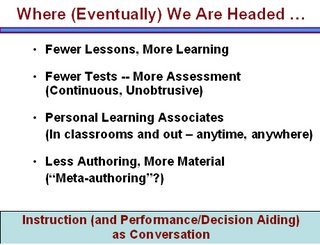Two things tell you an industry is maturing and will not be as much fun. The US Census Department recognizes it in the North American Industry Classification System. A major benefit is that news and other researchers now have access to county level data. The second is when Wall Street creates an industry index fund for investors.
About four years ago we vigorously campaigned the U.S. Census Department to include eLearning but to no avail. Looks like many more years of waiting because of their 7 year upgrade cycle. At about the same time I created and have been tracking a virtual eLearning Industry Index fund. With dominance by a couple of major players, consolidations, failures, Riverdeep going private, and other major players owned by larger companies the results are too volatile to be ready for Wall Street.
Last week I decided to checkout the current eLearning territory with a Wall Street researcher.
S. Andrew St. Pierre, VP Information Technology research for citigroup’s Smith Barney was in town giving a presentation at the Arizona Technology Council’s breakfast “Council Connect.” His delightful presentation included analysis and forecasts for data networks, storage and software. At one point he mentioned that IT industries were becoming mature. There are lots of new features but no new “killer software application” was on the horizon. He just saw expanded use of current technologies. He lamented the lack of “disruptive technologies” reaching the IT marketplace. (Image how the turbojet engine disrupted the piston engine aviation market in the 1950-60’s)
Not being able to resist the temptation, I asked him if Wall Street tecno-gurus ever considered “eruptive markets.” “If Arizona goes to 1:1 eLearning in ten years, the market for data networks to deliver instruction will increase 20 to 100 times. Computers with software will increase 20 times to 300,000 units a year.” From his answer I once again realized that Wall Street is almost totally focused in the short term – one year or less. The serve speculators; including the institutions not long range investors. The longer range investors; “value” (5 to 10 year horizon) and “income” (10 to 30 years); are of little interest (no-fees!!!).
Chatting with Andrew afterward he lamented the lack of focus on eLearning emerging markets with longer range analysis and forecasts. But he did say that his investment tips for the start of 2007 was HP (great recovery) and Cisco (data networks).




















